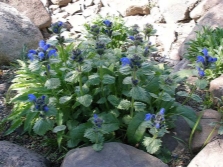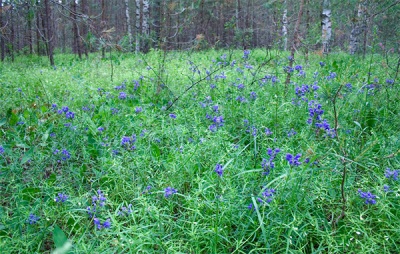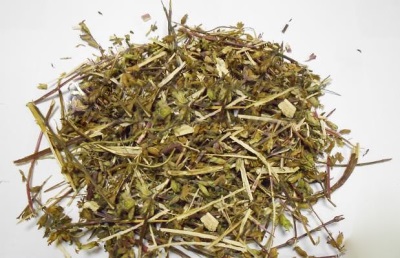snakehead

"Dracocephalum" - this name was given to this plant by the ancient Greeks, which means "head of a snake." People call this plant in different ways: mother liquor (beekeepers treat the hive with it before placing a bee swarm there), Turkish lemon balm, bruise (obviously due to the color of the flower), dragonhead.

Appearance
The snakehead is a perennial. It is not by chance that the plant has such an interesting name. Indeed, its flowers are similar to the head of a snake, which seems to have its mouth open.
Plant height ranges from 50 to 70 cm.
The tetrahedral stem is crowned with an inflorescence of large purple or light blue flowers. The snakehead blooms from the lower inflorescences. Flowering time - July-August. The plant in the phase of full flowering dissolves 562 flowers.
Taproot, from which small roots extend.
The leaves of the snakehead are oval, opposite. The edges of the leaves are not even, but serrated. By September, the first seeds ripen. They are triangular and dark brown in color.

Kinds
There are about forty plant species. Let's dwell on the most common:
- Moldavian snakehead resistant to cold and drought. In general, quite unpretentious. It is characterized by a long flowering period: July - the end of September.
- Large-flowered snakehead - perennial, whose height is about 40 cm. The plant feels good both in the shade and in the sun. But the soil for it should be well fertilized and loosened.The flowers of this snakehead have a bright blue color.
- foreign snakehead found in northwestern Mongolia and China. Siberia is also the place of its growth. This plant needs rocky soil. The root of the foreign snake head is powerful and strong, and the height of the plant can be either 15 cm or 65 cm. The flowering bouquet located in the upper part of the representative of the flora is 10 cm in diameter.
- Ruysch snakehead. The distribution area of the Ruysch snakehead is Kazakhstan, Siberia, the Far East, the Eastern part of Europe, Central Asia. Steppe, places with dry pine forest, forest edge, mountainous terrain - these are the places of its growth. The plant has a thick massive root. Ruysch's snakehead is quite tall. The height of the ground part can reach 50 cm. New shoots appear in the summer-autumn period.



Where does it grow?
Since the snakehead is very unpretentious, it can be found almost anywhere in the world. He feels great in the subtropics and in cold places. Europe, America, Asia, India, China - its habitat.

spice making method
The flowering time of the plant is the time of its collection. You can cut off the above-ground part or pull out the snakehead directly with the spine. But ideally, you should use a part of the plant that is located 10-15 cm from the earth's surface. Closer to the soil, the stem is coarse. It is difficult and inconvenient to handle.
Before drying, the raw materials should not be crushed too much, then as much of the precious essential oil as possible will be preserved in it. It is necessary to dry either in the shade or in a dryer, where the temperature reaches + 40 ° C. The herb dried in this way can be stored in an airtight container. This will keep the fragrance for a long time.

Use dry grass in the preparation of various dishes should be careful, as its smell is very pronounced.
Characteristics
- a sharp lemon smell;
- honey plant.
The snakehead has a very strong, even sharp lemon smell, which is similar to lemon balm. Therefore, it can be attributed to spicy plants.
The strong aroma of grass is not liked by many insects that are pests of vegetables growing in our garden. In this regard, the snakehead can be used as a means of combating such parasites. The aroma of a flowering plant attracts bees. The snakehead is a honey plant.

Useful material
The percentage of nutrients in a dry product
| Essential oils | 0,28% |
|---|---|
| Ash | 10% |
| Protein nitrogen | 0,3% |
| Protein | 2,2% |
In order to learn more about the snakehead, we recommend watching the video from the program "1000 and one spice of Scheherazade".
Chemical composition
- vitamins;
- tannic acids;
- flavonoids;
- coumarins;
- oils and acids;
- iron;
- potassium;
- magnesium;
- zinc.
The snakehead is a pantry of vitamins, tannic acids, flavonoids, coumarins. And the seeds contain oils and acids (palmic, stearic, linolenic, oleic). Iron, potassium, magnesium and zinc are present in the chemical composition of the roots of the plant.

Beneficial features
- soothing, astringent, anticonvulsant, restorative properties;
- from toothaches and headaches;
- from colds;
- stimulates appetite;
- strengthens the immune system;
- beneficial effect on the functioning of the kidneys;
- antiseptic;
- used to treat gynecological diseases.
Useful properties of snakehead have been known since ancient times. Its soothing, astringent and firming properties have been used in Tibet and India. In addition, snakehead is very useful for loss of appetite.It has a positive effect on the human digestive organs.
With neuralgia and arrhythmias, snakehead can also help. It relieves toothache, strengthens the immune system.
Wounds and burns treated with snakehead heal much faster. It is a powerful antiseptic, so it is indispensable for stomatitis. Zmeegolovnik is used in the treatment of rhinitis, sinusitis and throat diseases.
Useful serpentine in diseases of the kidneys.
No less useful is the essential oil of the plant. It can be used as a laxative and antispasmodic.



Harm
- can cause allergies;
- contraindicated in people who cannot tolerate it.
Naturally, with individual intolerance, it cannot be used. This can cause allergies, which will manifest as a skin rash or indigestion.
Application
In cooking
The snakehead is added to:
- in confectionery;
- beverages;
- soups;
- main dishes and salads;
- marinades.
The presence of essential oils and a pronounced lemon smell makes the snakehead indispensable in cooking. Flavor them with confectionery. As a flavoring agent, it is an additive in non-alcoholic (tea, compote, kvass) and alcoholic drinks (vermouth).
All the delicate aroma is concentrated in the leaves of the snakehead. Therefore, they are fresh or dry, as well as flowers are used in culinary recipes.
Flowers can be a wonderful decoration for a dish.

The snakehead gives a piquant taste to summer salads, soups, fish dishes. This spice is also added to meat dishes.
In order to balance the taste of the dish, from 0.2 to 0.4 g of dry spice is used for one serving of the dish. The time of laying the spice contributes to the preservation of the aroma: 3 minutes before the soup or broth is ready, and in the salad almost before use.High temperatures "kill" the flavor, so the snakehead is added almost before serving the finished dish.
The snakehead is used as an independent spice, and in mixtures with other herbs. The following herbal mixture is added to the yogurt-based sauce (for lamb, fried fish, salads): snakehead, fennel, tarragon, anise. Mint in combination with snakehead decorates drinks (compote, kvass).

Another area of culinary use of the snakehead is marinades. Star anise, cinnamon, cloves and snakehead make a great marinade mix for fruits and vegetables.
It's not hard to make lemon salt. All you need to do is make a mix of lemon zest, pepper, snakehead and, of course, salt.
A savory chicken marinade is obtained by mixing snakehead with tarragon oil, adding yarrow and wormwood.

Tea
In autumn, when colds get worse, warming pleasant tea is simply necessary. To prepare it, boil a liter of water. You should take 2-3 tablespoons of snakehead and insist them in boiling water. Then add a tablespoon of honey, cranberry juice (half a glass). If cranberry juice is not available, a glass of crushed cranberries can be used. Everything is thoroughly mixed. Strain the infusion and drink hot.

Vinegar
Vinegar based on snakehead and lavender is a great salad dressing. Its preparation will not cause any special difficulties. To do this, two branches of the plants named above are taken and infused in the dark in half a liter of wine-vinegar mixture (one part of vinegar and 10 parts of white wine). Two weeks later, the composition is ready.
In medicine
The snakehead is used for:
- tachycardia;
- neuralgia;
- migraine;
- colds;
- loss of appetite and to improve digestion.
External use (compresses and lotions):
- toothache;
- rheumatism;
- various injuries.
The snakehead is used in medicine in the form of tinctures and decoctions. This is an excellent remedy for loosened nerves, relieving pain, with pyelonephritis.
To make soothing tea take snakehead, peppermint, oregano. Equal parts of these plants are mixed and brewed with boiling water. For a liter of boiling water, take three tablespoons of this mixture.
To prepare an infusion, you will need a tablespoon of dry snakehead per glass of water. The raw material is poured with boiling water. After 15 minutes, the infusion is ready. It should be drunk half a cup three times a day. It is useful for increased fatigue.
Serpentine - a good remedy for the treatment of bronchitis. Inhalation in this case is the most effective method of treatment. It is enough to breathe for 10 minutes over a container of water, in which 2-3 tablespoons of dry grass are added, and you will feel a clear relief.
Doctors recommend the use of sitz baths with snakehead for disorders of the genitourinary system. To prepare such a bath, you need to insist 200 grams of dry snakehead in a bucket of boiling water for 20 minutes. After filtering, the water is poured into a basin for further procedures. In this case, the temperature of the resulting broth should not be higher than 39 °. Take this bath for 10-15 minutes.



The most important thing when using preparations based on this fragrant herb is to make sure that there is no allergy to it!
In cosmetology
- used to make massage oil;
- essential oil is used in soap making;
- is a component in the production of expensive perfumes.
With the help of this plant, it is possible to prepare an excellent oil for massage. The cooking process does not cause any particular difficulty.You need to take vegetable or olive oil and pour it over the dried snakehead. Place the mixture in a dark place. Within 2-3 days there is an infusion of oil. You are only required to occasionally shake the container with the contents. After filtering, the resulting oil should be poured over a new portion of the herb. This procedure should be repeated three times. As a result, an oil is obtained that has a unique aroma, which is used in massage. Relaxing and calming effect is guaranteed.
Another advantage of this oil is its beneficial effect on the skin..Perfume and cosmetics industry uses snakehead essential oil in the production of perfume. As an aromatic substance, it is also added in the manufacture of soap.



cultivation
In view of its unpretentiousness, growing snakeheads in the area near the house or in the garden will not cause any particular difficulties. Keep in mind that the snakehead loves light. It also needs a lot of water when it is just starting to grow. A fully flowering plant tolerates drought, but a lack of moisture can negatively affect the presence of greenery in the plant.

Superphosphate (20 grams per 1 square meter) and potassium salt (15 grams per 1 square meter) are used as fertilizers. They fertilize the soil in the fall. And in the spring, nitrogen fertilizers are added.
Serpentine seeds should never be soaked, as gardeners do with many crops. They just stick together and it will be impossible to plant them.
Seeds are planted from May 1 to May 10 in grooves, which must first be shed with water. The depth of such a furrow is 1-2 cm. A distance of 45 cm is maintained between rows. The most important thing during this period is the prevention of a dried-out earthen crust. If everything is done correctly, then in a maximum of two weeks the first growth will appear.

It is necessary to plant seeds in soil that has warmed up sufficiently. Otherwise, the plant can be damaged by root rot. The growth process of the snakehead for the first month and a half is very long. The plant must be carefully looked after: loosen, weed. But then, then he is not afraid of any weeds, and it quickly goes into growth.
After 2.5 months from the moment the first shoots appeared, the snakehead begins to delight with its flowering inflorescences. Since the seeds ripen gradually, and not all at once, it is recommended to cut off the inflorescences after the last flower on the plant has faded and dry. The drying area must be well ventilated. Then you can collect the seeds.
The snakehead allows you to create beautiful compositions on the site. It pairs well with marigolds. With it, you can emphasize the edges of the garden path. Plus, it will delight you with its unique aroma when you walk around your cozy garden.


















I liked the snakehead lemon dressing recipe. I think it's both useful and tasty)